 |
|
|
|
|
|
|
Disturbance has a strong influence on the structure and
dynamics of subalpine forests. In general, growth and survival of plants
is determined by the availability of resources such as light, water and
nutrients at their site. But, the structure and dynamics of a forest is
not only the result of supply and demand of resources. It is to a large
extent effected by disturbance of biotic or abiotic origin, interrupting
and hence disturbing the "normal" life cycle of a tree and the dynamics
of a forest. |
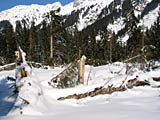 1 1
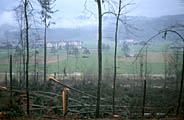 2 2
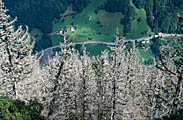 3 3
 4 4
 5 5
|
|
| 1, 2 - | The breaking of individual trees or whole tree populations under the effect of a disturbance caused by avalanches (1) or wind storms (2) leads to an abrupt change in the succession dynamics of the forest structure. Photos: V. Stöckli (112K, 61K) |
| 3 - | Forest dieback under the effect of the bark beetle. The area was previously hit by a storm. ("1990 storm Vivian", Gandberg, Glarus, Switzerland). Photo: V. Stöckli (115K) |
| 4 - | Caterpillars of moths, like the Zeiraphera diniana (larch bud moth), feed on the newly developing needles of Larix decidua (European larch). The population dynamics of the moth result in repeated calamities about every ten years. Photo: F.H. Schweingruber (115K) |
| 5 - | Growth pattern of a larch, periodically attacked by the larch bud moth. The herbivore only rarely causes dieback of European larch, but the energy loss is reflected in considerable reductions of radial growth. Photo: F.H. Schweingruber (115K) |
|
Disturbance through avalanches Disturbance in subalpine areas is frequently caused by avalanches. Forest in steep terrain (> 25° inclination) or immediately below it is exposed to avalanche hazard. Avalanches exert a high pressure on trees in their wake. Trees with elastic main stems are bent down and may overcome the impact without major injuries. Elastic stems are exhibited by smaller trees with stem diameters < 10cm, as well as of krummholz species such as Pinus mugo or Alnus viridis. These trees are often found occupying large areas in avalanche tracks, regularly overrun by avalanches. Trees of stem diameters > 10cm are fully exposed to the pressure of avalanches and may break. In the Swiss Alps, many avalanches yearly cause many m3 of wood to be blown down. In the extremely snow-rich and avalanche-prone winter of 1999, a sum of 450 avalanches were recorded causing more than 1400ha of forest to be blown down, corresponding to 160 000m3 of wood debris. One of the largest avalanches blew down 35ha of forest (8000m3 of wood, Bisistal, Schwyz). Through their destructive forces avalanches cause large openings as vertical tracks in the subalpine forest belt. Depending on the frequency of avalanches and the amount of time since the last event, the vegetation structure exhibits an increased diversity of plant species. Ground cover vegetation and small shrubs profit from the resources newly available through the disturbance of the trees. |
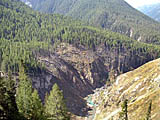 6 6 |
 |
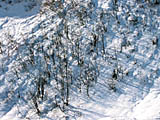 7 7 |
|
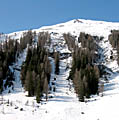 8 8 |
9 - Species diversity increases in avalanche tracks of increasing frequency of disturbance in the Dischma valley, Switzerland |
|
| 6 - | A dust avalanche caused breaking of trees in the passing zone in the foreground and an uprooting of trees in the uphill direction in the runout-zone on the opposite slope (1999, Ofenpass, Switzerland). Photo: V. Stöckli (133K) |
| 7 - | The Krummholz Pinus mugo and Alnus viridis exhibit small size as well as curved and comparably flexible stem forms, enabling them to grow in traditional avalanche tracks. (Bärental, Switzerland). Photo: V. Stöckli (135K) |
| 8 - | The subalpine forest belt is interrupted vertically by avalanche tracks. (Dischma valley, Switzerland). Photo: V. Stöckli (75K) |
Disturbance trough parasitic fungi Fungal species such as Fomes annosus may cause considerable growth reduction or even die-back by decomposing essential root wood composites of trees. Entering the water conducting elements, they reduce the physiologically active parts of a tree, occasionally leading to tree death. Through their vegetative propagation, parasitic root fungi often cause whole cohorts of trees to die. Acting under ground, this often disastrous activity is rarely attributed to the fungi, but to the secondarily active bark beetles. |
||
Photo: V. Stöckli (80K) |
||
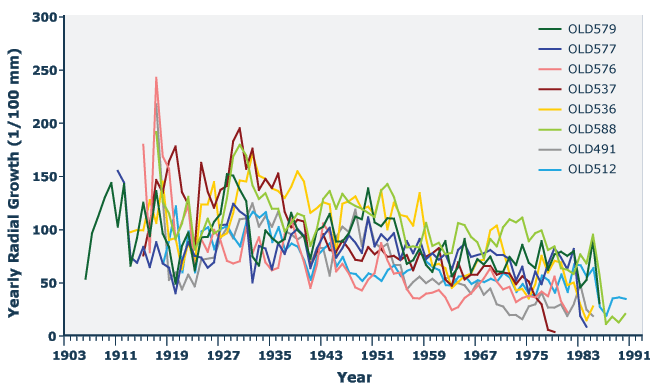 |
|
| 11 - Sudden death of individual Pinus mugo ssp. uncinata trees in the Swiss National Park | |
|
Eidg. Institut für Schnee- und Lawinenforschung SLF,
Davos Eidg. Institut für Schnee- und Lawinenforschung (Hrsg.),
Schadenlawinen - Datenbank. Der Lawinenwinter 1999. Ereignisanalyse,
2000, Davos, Eidg. Institut für Schnee- und Lawinenforschung. 588
p. |
29 August 2011 |
||
| |
||
